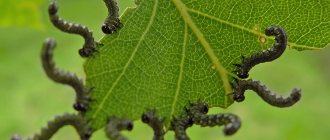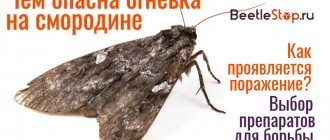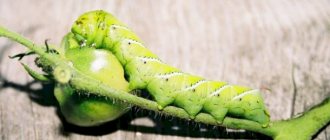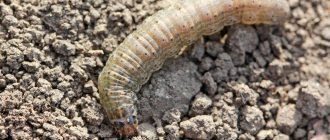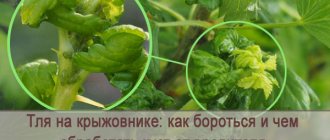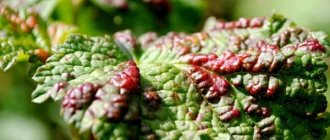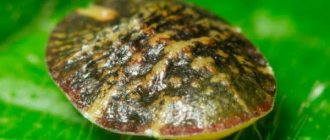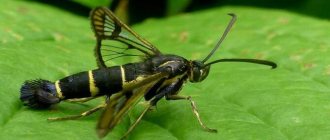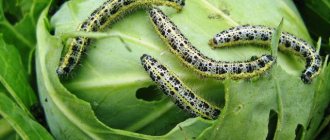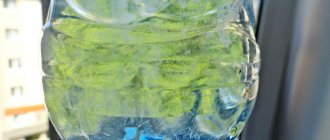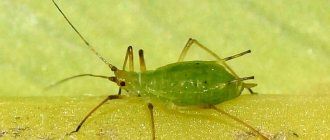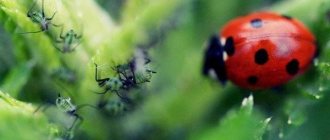When caterpillars on currants completely eat the leaves, this is not uncommon. Some overwintering pests appear in early spring, while others appear throughout the season. They feed on young leaves, shoots, flowers, and ovaries. This significantly weakens the bushes’ immunity, reduces yield and increases the likelihood of fungal diseases. If measures are not taken in a timely manner, the plant will wither and eventually die. But before you start fighting pests, you need to know what types of caterpillars infect currants, and also become familiar with possible methods of destroying them.
Symptoms of the lesion
The first sign of a plant being attacked by pests is the appearance of butterflies flying up on the bush. These cute creatures don't just circle the leaves. Their main goal is to lay eggs. If you start fighting insects during this period, you can sharply reduce the number of larvae that have settled on the bushes.
As insects multiply, the following signs of infection appear:
- swollen kidneys;
- growths on shoots;
- holes of various sizes, pads and plaque on the leaves;
- deformed parts of the plant;
- drying flowers and ovary.
Furrow mower: spring treatment of blackcurrant bushes from pests
Sulcata mower Otiorrhynchus sulcatus Fabr.
Weevil beetle 8-10 mm long, pitch-black, with a metallic sheen, hips with a tooth. The rostrum is clearly expanded at the apex; it has a deep and wide longitudinal groove. Spring treatment of currants against pests of this type includes collecting and burning all plant residues. Then the treatment of currant bushes from pests is carried out by spraying them with insecticides.
The larva is small, white, legless, cylindrical, somewhat curved, with a brown head. The larvae feed and develop in the roots of plants, making passages in the wood. The beetles damage the leaves, eating the edges in small areas, shallowly, in a patterned manner, and also damage the buds. The furrow mower often damages currants, raspberries, grapes, apricots and deciduous shrubs and trees.
Control measures. Preventive treatment of black currants against pests after flowering with one of the drugs: fufanon, kemifos, actellik.
Types of caterpillars that can eat green bushes
In order to promptly detect the presence of pests and begin combating, you need to know what they look like. And also on what parts of the bushes they reproduce.
Currant bud
The eggs of this pest appear on the plant thanks to a moth with stripes on its wings. The female currant moth lays eggs in dormant buds and setting berries. The hatched larvae begin to eat away the tissue from the inside.
Kidney moth caterpillars are red immediately after birth and then turn green. Before pupation, the parasites descend from the bushes and burrow into the ground. In autumn, moths emerge from the pupae and lay eggs in the soil, dry leaves and branches.
Gooseberry moth
A common pest of all types of currants and gooseberries. A female moth lays up to 200 eggs during its life cycle. The pest becomes active during flowering. The hatched larvae quickly spread throughout the bush and begin to destroy the leaves and then the berries. The main symptom of a plant being infected with the gooseberry moth is fruits entangled in cobwebs.
Gallica
It can be stem or shoot. The pest forms growths called galls on currant stems, which contain eggs laid by the mosquito. After maturation, small caterpillar larvae crawl out of them. At first they are small, up to 4 mm in length, white. As the caterpillar matures, it turns yellow or orange.
Palefoot and yellow sawflies
The insect causes serious damage to currants and gooseberries, and therefore is recognized as one of the most dangerous pests of these crops. The first generation of caterpillars settles on red currants. Because it blooms earlier than other varieties. The second loves gooseberries and black currants. For the third generation of pests, one gooseberry is enough.
Sawflies are reddish-yellow or dark-colored insects with light spots on the body. The larvae of the pest are greenish-blue caterpillars with ten pairs of legs.
There are two main types of pests:
- Sawfly (yellow) of red currant. As a rule, it affects black and red currants, less often it settles on gooseberries. The development cycle of this pest lasts only 30 days.
- The blackcurrant fruit sawfly is a dark-colored insect with yellow legs. The larva has a dirty white color. She is all wrinkled and covered with hairs, with a yellow head.
leaf roller
The caterpillar is colored light green or yellowish. The body is additionally covered with dark dots. The pest's head is yellow, brown or black.
The larvae feed on young, recently blossomed leaves, wrapping themselves in them and entangling them with cobwebs. Curled leaves dry out and fall off. They are then carried by the wind to other plants.
Moth
The gooseberry and currant moth caterpillar is white and has a pattern of quadrangular black spots. There is an orange stripe on the sides of the pest. The length of an adult caterpillar is 35–40 mm.
The insect feeds on the leaves, completely destroying them. Pupation of caterpillars occurs in June. Yellow cocoons with a black stripe appear on the bushes. Gradually they fall off. The pupae overwinter in the foliage under bushes.
Glassware
The caterpillar infects black and red currants and settles inside young shoots. The body of the pest is white, the head is black. The larvae feed on the tissues of the stems and overwinter in them. Pupation occurs in early June. The pest waits out frosts in the soil and dry leaves.
Gooseberry moth caterpillar on currants
From the name it is clear that this pest eats gooseberries, but it also does not ignore red and white currants. This caterpillar almost completely destroys the leaves of the bush.
The caterpillar of the voracious moth is quite large (about 4 cm), the color is gray with yellow stripes and black spots.
In the second half of summer, the moth butterfly lays eggs on the inside of the leaf. By autumn, the caterpillar is entwined with a web and sleeps all winter with fallen leaves. In spring, active currant feeding begins.
How to deal with the pest?
Gardeners have accumulated many ways to destroy currant pests in their arsenal.
Mechanical methods of struggle
Caterpillars are quite large and noticeable pests. Therefore, in the early stages of infection they can be removed mechanically:
- Shaking off. They spread cloth or paper around the bush and begin to shake the branches. The caterpillars fall off and become easy to destroy.
- Manual collection. Pests are collected, placed in a prepared container and burned.
- Scraping. The method is used if the caterpillars are attached to currant stems. Pests are scraped off with hard brushes or metal sponges soaked in a soapy solution.
- Opening up growths. The method is used to combat stem or shoot gall midge larvae. The growths are cut with a knife and the internal contents are cleaned.
Attention! Despite their apparent simplicity, mechanical methods of fighting have a drawback. They do not provide 100% protection against pests and are effective only in the early stages of infection. Even one larva remaining on the plant will soon restore the population and continue to harm the currants.
Chemicals
Treating bushes with insecticides is the most effective measure for exterminating pests. According to gardeners, the following drugs are highly effective:
- Spark – has a wide spectrum of action. Consists of a combination of permethrin and cypermethrin. Spraying with this poison is carried out 3 times per season. Before buds break, during flowering and after picking berries. The drug is most effective at temperatures above 25 degrees. In cold weather, the effect of the poison on pests is very weak.
- Fufanon. Highly active contact insecticide. Effective at temperatures from + 15 degrees. To destroy caterpillars, 2 treatments with an interval of 20 days are sufficient. The concentration of the solution is 1 ml per 1 liter of water.
- Karbofos. A drug based on malathion. Effective in the fight against leaf rollers, glass beetles and mites. Treatment with karbofos is carried out 3 times per season. At the beginning of bud break, during the formation of buds and after picking berries. A solution is prepared from 30 g of karbofos per 4 liters of water. Consumption rate – 2 liters per bush.
- Alatar. The drug has a wide spectrum of action, destroys 28 types of insect pests. The insecticide is based on 2 substances – malathion and cypermethrin. To spray bushes, 5 ml of the drug is dissolved in 4 liters of water. Process 2 - 3 times.
- Actellik is a universal drug for exterminating insect pests. The main active ingredient is pirimiphos methyl. It penetrates the digestive system of parasites and causes their death within 5 to 6 hours after contact. To prepare a working solution, dissolve 2 ml in 2 liters of water.
Important! Insecticides to control caterpillars are used only when absolutely necessary. Most drugs are dangerous for bees, earthworms and beneficial microflora in the soil.
Biological drugs
Opponents of the use of chemicals in garden plots prefer to protect currants from pests with bioinsecticides. Their action is based on the colonization of bushes with beneficial microorganisms, which, by multiplying, destroy parasites.
To combat caterpillars, currants are treated with the following means:
- Lepidocide. A special biological product for the fight against butterfly larvae: moths, leaf rollers, moths. The death of caterpillars begins 3–5 days after treatment. Within 2 weeks, most of the pests are neutralized. After repeated treatment, 90% of the caterpillars die. To prepare a solution, 30 g of the drug is diluted with 10 liters of water. Processed at temperatures from + 18 to + 30 degrees. Lower and higher rates reduce the effectiveness of the drug by 3 times.
- Fitoverm. Low-toxic organic insecticide against moths and leaf rollers. The active base of Fitoverm is aversectin. This is an unstable compound that is completely destroyed in fruits and leaves within three days. The poison enters the insect's body through the digestive tract. It paralyzes even in small quantities and kills in a couple of hours. You can poison caterpillars several times a season at any stage of the growing season, except flowering. Allow 10-20 days between treatments. Dry weather is desirable during and after the procedure. The concentration of the solution is 4 ml per 1 liter of water.
- Spark Bio. The active ingredient of the drug is Avertin N - a biological systemic pesticide with cumulative and fumigation effects. Interferes with the transmission of nerve impulses in insects and does not cause resistance. Rapidly decomposes on plant surfaces and in soil. Therefore, it has a short waiting period - only 3 days. At high air temperatures, efficiency does not decrease. Moreover, in the heat of +25 degrees and above, it only increases. The solution is prepared from 20–30 ml of the substance per 3–5 liters of water.
- Bitoxibacillin. The drug contains spores of the bacteria Bacillus thuringiensis var. thuringiensis. It begins to act 4 – 5 hours after the caterpillars eat the leaves treated with the product. To prepare the solution, take water at a temperature no higher than 20 degrees, otherwise sporulation will begin and the activity of the substance will be lost. Concentration of the product is 80 - 100 g per 10 liters of water.
- Nemabact. A unique preparation containing an entomopathogenic nematode. After tilling the soil, worms infected with symbiotic bacteria begin to lead their usual lives, destroying harmful relatives. The bacterium settles in insect larvae and feeds on its host. To prepare the solution, open the package and leave it at room temperature for 8–10 hours so that the nematode comes to life and becomes active. Then the resulting composition is diluted with water in a ratio of 1:100 and applied to the soil with regular watering.
Reference! The high effectiveness of bioinsecticidal preparations is based on the reproduction and destructive action of pathogenic fungi and viruses that infect the body of insects.
Traditional methods
If the pests have just begun to attack the currants, you can deal with them using traditional methods. Preparations prepared from improvised means are harmless to humans.
Therefore, they can be used even during fruiting:
- Laundry soap. A standard size piece is rubbed and dissolved in 1 liter of water. The bushes are sprayed every 10–15 days.
- Mustard infusion. For 3 liters of water take 2 tbsp. l. dry mustard powder. Water the bushes with the infused product for 60 minutes.
- Garlic tincture. Grate 3-4 cloves of garlic, add 1 liter of water. Infuse for a week in a tightly sealed container. Before use, the tincture is diluted in proportions of 1:10. If you water the leaves with undiluted product, you can burn the bush.
- Hot pepper infusion. 100 g of pepper is crushed and poured into 1 liter of hot water. The product is infused for 2-3 days. The bushes are sprayed with infusion diluted in a ratio of 1:10.
- Decoction of tomato tops. 1 kg of raw materials is crushed, 10 liters of water are poured in and heated over low heat for 40 minutes. To increase efficiency, add 40 g of laundry soap to the strained broth.
Important! If there is a significant proliferation of pests, drugs prepared according to folk recipes are not effective. Therefore, it is useless to use them.
Warning
To protect currants, a whole range of measures is used: preventive, agrotechnical, mechanical, biological and chemical.
To prevent the spread of pests and diseases, purchased seedlings are kept in quarantine schools, and upon purchase the quarantine certificate is checked.
Agrotechnical measures, including watering, weeding, fertilizing and pruning plants, allow you to grow strong and healthy currants; pests attack them only during a reproduction outbreak. They also try to select varieties that are resistant to pests living in the area.
Mechanical methods involve manually collecting and shaking off caterpillars, tearing off spider nests and rolled leaves, followed by burning them.
Biological methods are based on the use of natural enemies of pests: birds, amphibians, insects and microorganisms. Installing nesting houses and bird baths in the garden will attract the gardener's first assistants - sparrows and tits, and other insectivorous birds.
Instead of chemical insecticides that are dangerous to humans, nowadays it is possible to use biological insecticides. Their action is based on the destructive action of fungi, viruses, and entomopathogenic nematodes.
There are quite a few names of bioinsecticides suitable for killing caterpillars: Aversectin-S, Avertin-N, Bitoxibacillin, Dendrobacillin, Lepidocid, Entobacterin, Nembakt.
However, in the event of a strong outbreak of caterpillar reproduction, it is necessary to use chemicals that, although unsafe, very quickly cope with pests: Aktara, Akarin, Aktellik, Apache, Bi-58 Novy, Inta-Vir, Fufanon-Nova.
The gardener makes the decision on how to treat currants when caterpillars appear depending on the condition of the plant, the number of pests and the time of their appearance.
Prevention
Proper care of currants is the best prevention of caterpillars breeding on bushes. The following measures help prevent infection:
- Cleaning up fallen leaves and digging up the soil under the bushes before wintering. All plant residues are burned. The soil is sprinkled with ash, tobacco and mulched with a layer of 10–15 cm.
- Timely sanitary pruning of damaged and dried stems. Eggs and larvae of pests may be located inside dry shoots, so they are burned after the procedure.
- Formative pruning. Too dense bushes create comfortable conditions for pests, and they multiply unhindered. Therefore, currants must be regularly freed from old shoots.
- Preventive spraying of bushes in early spring. An excellent way to prevent pest infestation is to treat the bushes with a solution of laundry soap at the stage of bud formation. To prepare the product, use hot water (50 - 60 degrees).
Caterpillars not only spoil the appearance of currant bushes, but also actively destroy flowers and ovaries. Even a small number of pests that settle on a plant reduce its immunity. This negatively affects productivity. Having destroyed the above-ground part, the pests move into the soil and begin to feed on the roots. If measures to get rid of parasites are not taken in a timely manner, the plant will die.
5/5 — (1 vote)
Other ways to fight
Experienced summer residents practice simple but effective methods of controlling caterpillars on currants without the use of pesticides:
- Processing with boiling water . It is carried out before the buds open. Currant branches are tied into a bunch and poured with hot water, killing overwintered parasites. Adding creolin or laundry soap to hot water increases the effectiveness of the procedure.
- Manual collection . The bushes are inspected daily, caterpillars are collected, and special attention is paid to egg clutches located on the inner surface of the leaves. The collected pests are destroyed.
- Shaking off . A light cloth or paper is spread under the plant, and the currant branches are shaken thoroughly. Fallen caterpillars are immediately eliminated before they have time to crawl away.
- Attracting birds . Tits, starlings, and wagtails are the gardener’s faithful assistants in the fight against caterpillars. One bird can destroy more than 100 parasites per day. The installation of birdhouses and feeders in winter helps to populate the summer cottage with useful birds.
- Growing plants with repellent properties . Calendula, nasturtium, and marigolds are planted between currant rows. Phytoncides and essential oils repel adult pests and make it uncomfortable for caterpillars to stay on the bush. An apothecary garden with fragrant herbs - lavender, sage, valerian, mint - will undoubtedly be beneficial.
- Attracting entomophagous insects . Ground beetles, fire beetles and ichneumon wasps are formidable enemies of caterpillars. To populate the currant plantation with beneficial insects, honey plants and umbrella plants are grown nearby, and sheets of plywood or bricks are placed to shelter ground beetles during the daytime.
Alternative control measures are not able to completely destroy caterpillars on currants, but significantly reduce the number of uninvited guests on the bush.
Glassware
Spring pruning helps to identify damage to the bush by glassworm. The caterpillars of this pest live in currant shoots and leave behind wormholes. They feed on the inside of the shoots, making passages, which is why the branches stop growing, dry out and die.
Control measures
Every 2 weeks it is necessary to inspect the bushes and cut off (to the white core) the drying shoots in which the caterpillars have settled. You can treat glass currants with the same preparations as when fighting mites or bud moths.
